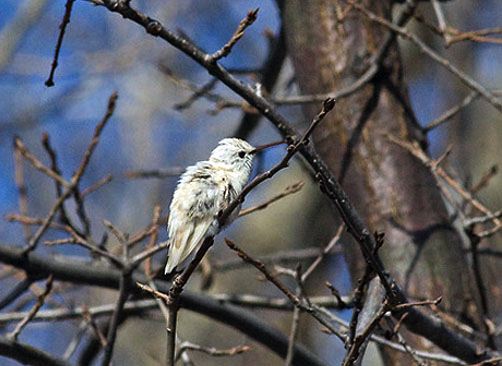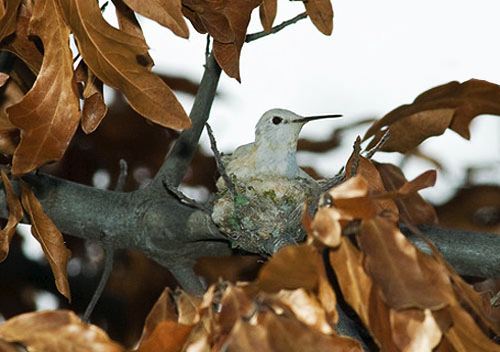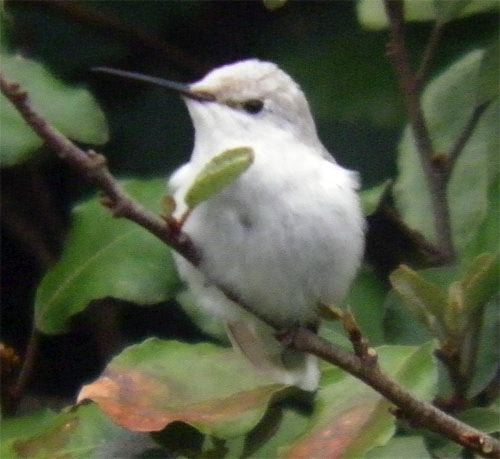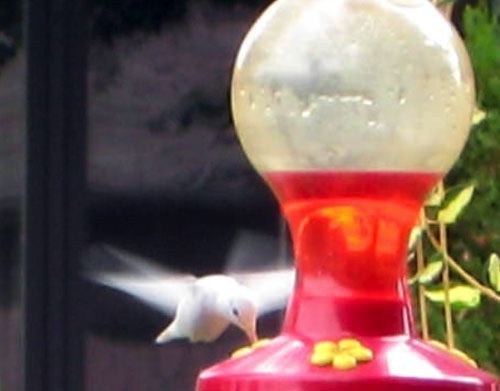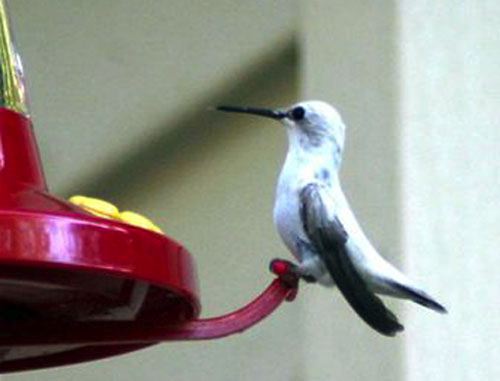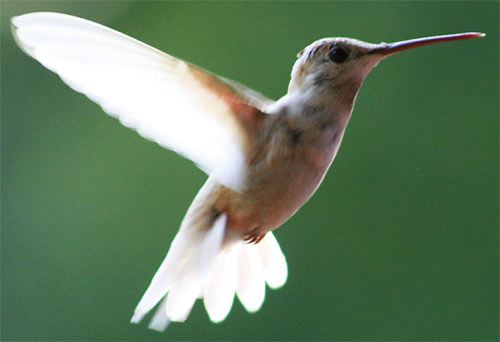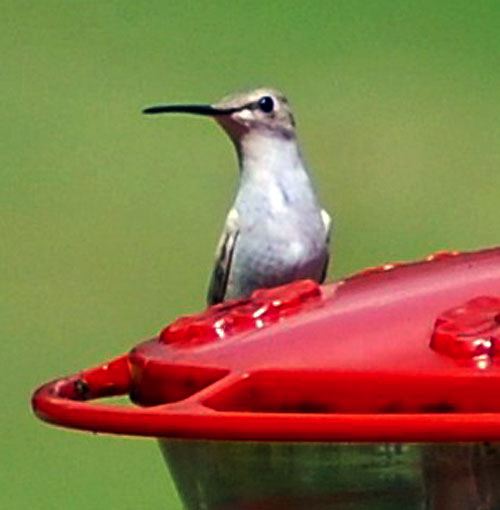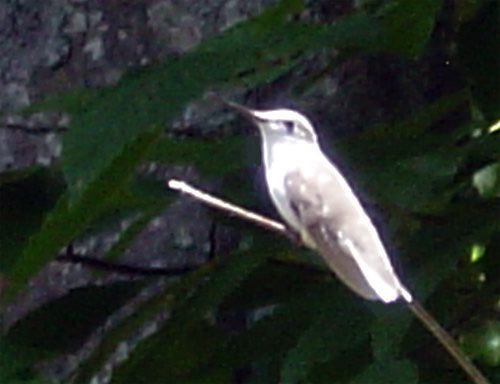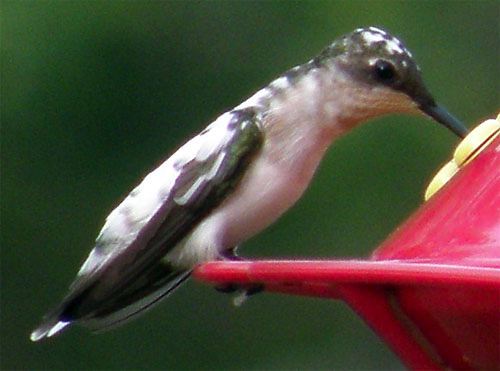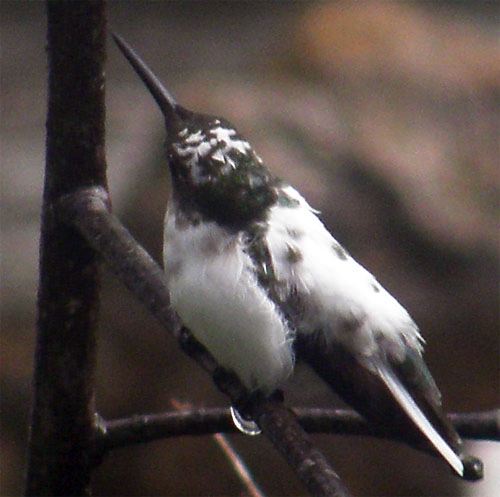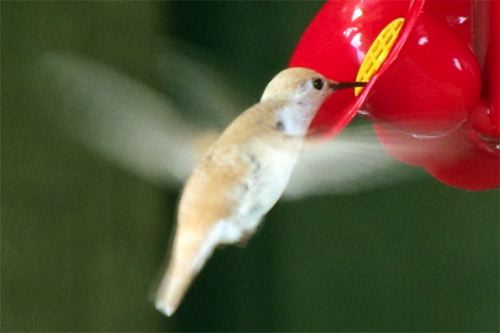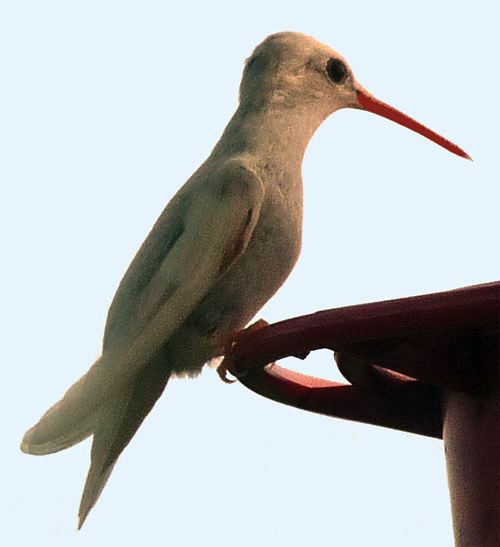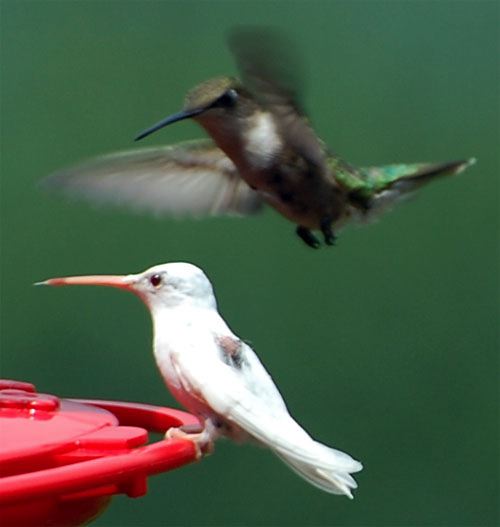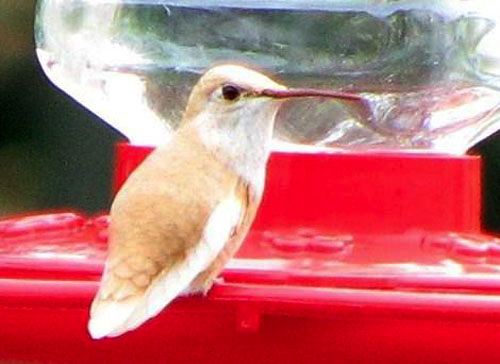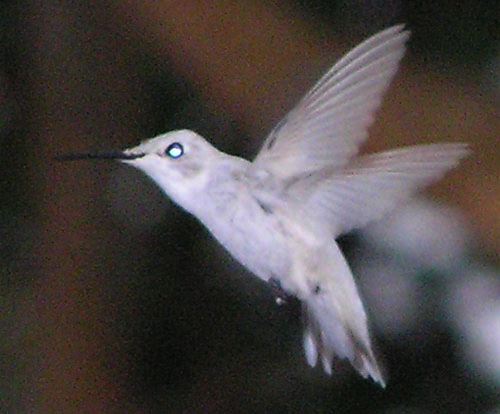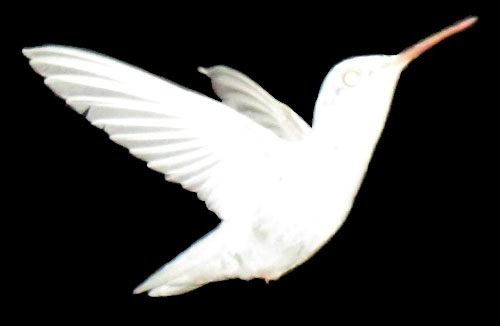|
|
|||
|
(Back to Preceding Week; on to Next Week) |
|
WHITE HUMMINGBIRDS 2010: Since 2007 we've devoted an end-of-hummingbird-season installment of "This Week at Hilton Pond" to a gallery of unusually colored hummers observed by folks around the country. We're talking about albino hummers (those that lack all pigment and bear pristine white plumage and pink eyes, feet, and bill), what we call "leucistos" (leucistic birds with more-or-less white feathers but having dark eyes, feet, and bill), and "pieds" (birds with some normal feathers and some that are white). Although we've never seen any of these pale hummers at Hilton Pond Center, we've banded several within South Carolina and elsewhere and have been helping compile reports of white hummingbirds from around the U.S. and Canada. We've also asked folks to send us photos of albinos or leucistos or pieds in their yards. This year we got fewer submissions than usual--a lot of them taken from a distance or with cell phone cameras that yield images too tiny to post--but we did get good ones we share below as our 2010 edition of "White Hummingbirds."
All text & photos © Hilton Pond Center The earliest 2010 submission of a white hummingbird photo (above) came 'way back in mid-February, so we were pretty confident this was NOT a Ruby-throated Hummingbird. That's because across much of their North American breeding range, ruby-throats don't even show up in spring until around the first of April. Besides, this year's February report was from Chris Aschenbrener of Sacramento CA--a pretty good indication the bird in question was a western species and, in particular, an Anna's Hummingbird. This species is typically sedentary in southern California and breeds quite early in the calendar year. Chris' bird--a leucisto with dark eye and bill and buffy highlights in wing and body feathers--was actually hanging out at El Dorado Nursery.
What was REALLY exciting about the Sacramento Anna's Hummingbird was it was a female that actually nested in an oak tree at the nursery. Breeding white hummingbirds are exceeding rare, in part because nearly all albinistic or leucistic hummers reported are young birds that don't make it to adulthood. We speculate "defective" white hummingbirds do not survive their first migratory flight to the Neotropics, mostly because black melanin they lack is a structural pigment that actually strengthens feathers in normal birds. Thus, structurally unsound white wing feathers become tattered quickly and wear out long before the migrants arrive at their winter destinations. Since Anna's Hummingbirds like the one Chris photographed at Sacramento don't migrate, chances of year-to-year survival increase greatly even if the bird has weak white feathers.
All text & photos © Hilton Pond Centers Although leucistic hummingbirds give the overall appearance of being white, the birds shown on this page show a great deal of plumage variation. Check out the female Ruby-throated Hummingbird reported in late September at Blossom TX by Becky Milford; this bird had completely white breast with a hint of buff in the crown and nape.
All text & photos © Hilton Pond Center Full albino hummingbirds like the one above are quite rare and very distinctive with their pristine white feathers and pinkish-orange bills. This albinistic Ruby-throated Hummingbird was observed on 26 September by Phil and Pat Zabst in Angola IN, where the hummer was visiting at least two feeders in the neighborhood.
All text & photos © Hilton Pond Center If reports we get are an accurate sample, it appears "pied" hummingbirds--with their odd-looking mix of white and normal feathers--are even more scarce than leucistos and albinos. Nonetheless, Carol and Tom Meyers welcomed a pied Ruby-throated Hummingbird (above) in southern Illinois on 12 September this year and it stayed until at least the 21st. Carol relates that when the above photo was taken Tom was hosting an estimated 200 other hummers and was using up 25 pounds of sugar every five days. Proving all those hummingbirds weren't addicted to artificial nectar, Carol said they were still making extensive visits to flowers in the Meyers' garden.
All text & photos © Hilton Pond Center Mark and Colette St. Peter first spotted the female leucistic Ruby-throated Hummingbird above on 12 September at Carthage MO. Note the almost translucent brownish bill that is typical of leucistos. The bird was coming to a feeder every 10-15 minutes during daylight hours for at least three days. All text & photos © Hilton Pond Center
All text & photos © Hilton Pond Center As is often the case with white hummingbirds, they put in a quick appearance and disappear. Such was the case on 28 August for Tamara Whiteside of Eads TN, when the leucistic Ruby-throated Hummingbird (above) stayed just long enough for her to snap a few photos. It's a bit hard to tell this bird is a leucisto until you remember that a normally colored ruby-throat has a dark green crown and shoulders.
All text & photos © Hilton Pond Center A couple of hours north of Hilton Pond Center is the little North Carolina mountain town of Valle Crucis, where Denise Weinkle spotted a leucistic Ruby-throated Hummingbird (above) on 18 July. This was a rather early date for a white ruby-throat; most reports we get come in August or September. This bird illustrates the leucistic "style" in which the bird is mostly white except for gray wings.
All text & photos © Hilton Pond Center Austin Mitchell lives in Dent County MO about 8 miles west of Salem. There he enjoys feeding hummingbirds and was elated on May 10 to see a hummer with very unusual markings. He ended up taking a very nice series of photos of a pied female ruby-throat--and one that almost certainly had to be an adult at that early date.
All text & photos © Hilton Pond Center Austin's bird had a green head with white speckles, dark wings with a few white coverts, a back that was almost all white (but not quite), and some tail feathers that were white and some that were normal. It will be interesting to see whether this bird returns next year to Austin's feeders; we're sure an observer would be able to recognize such a distinctive individual.
All text & photos © Hilton Pond Center On 28 September Rhonda Day of Eclectic AL photographed a leucistic Ruby-throated Hummingbird exhibiting one of the more common "styles" of leucism: White underside, dark bill and eye, and uniform buffiness on crown, back, and tail. Note the tail tips are white just like in a "normal" female or immature male ruby-throat.
All text & photos © Hilton Pond Center Loretta Kincaid of Jackson MO hosted a full albino Ruby-throated Hummingbird (above) at her feeder for about two weeks in early August. Based on large size and long bill length, his bird most likely was a female. Although the albino's pinkish-orange bill is quite evident in the image, it's very difficult to get a good picture of the red eye.
All text & photos © Hilton Pond Center Suzette Griffin of Banner Elk NC was able to photograph her albinistic Ruby-throated Hummingbird (above) in direct sunlight, so the red eyeis more apparent--as are the pik feet. This bird, first seen on 24 July and present through at least 28 August, is even more interesting because it has lost some of the feathers on its back--revealing the unpigmented pink skin of a true albino.
All text & photos © Hilton Pond Center Not every white hummer is a ruby-throat, of course, as illustrated by a Rufous Hummingbird (above) spotted by Jenny and Wayne Graevell at their getaway on Badger Mountain, outside of East Wenatchee WA. This bird came in with a rush of other hummers on the leading edge of a cold front pushing south the first week in August. It remained with them for several days and was very loyal to one particular feeder (out of 24 the Graevells maintain).
All text & photos © Hilton Pond Center This leucistic Ruby-throated Hummingbird was only observed for a couple of seconds on 28 August before one of the "guards" chased it away from Frank Moran's feeders at Harrisonburg VA. Frank managed to fire off one quick exposure (above); the silvery reflection in the eye is the result of the light from the flash bouncing off the hummer's retina.
All text & photos © Hilton Pond Center The photo above submitted by Becky Osborn of an albino Ruby-throated Hummingbird is about as close as one could get to depicting a "ghost hummer." The bird was in Becky's mother's yard at Terre Haute IN on 16 September, where she photographed it with a flash that again made the eye look silver rather than red. The rounded tip of the nicely outlined #6 primary feather indicates this bird is a female. All text & photos © Hilton Pond Center Our last image of a leucistic Ruby-throated hummingbird is actually a 12-second movie contributed by Steve Stallings, who we knew as a student when we taught at Fort Mill High School back in the late 1970s. Steve now lives in southern Gaston County NC, which borders our South Carolina home county of York. Just click once or twice on the image above to run a movie of the white hummer that showed up at Steve's feeder near the end of August. We think you'll agree white hummingbirds are fascinating and that it's fun to compare the various types. Thanks to everyone who was kind enough to share photos of their birds for Hilton Pond Center's 2010 version of "Albinos, Leucistos, and Pieds." If you're fortunate enough to attract a white hummer next year, please remember to e-mail your sharpest photos to RESEARCH for the 2011 edition. That way others will get to see yet another assortment of these amazing ghostly creatures. All text & photos © Hilton Pond Center If you have a Twitter account and liked this page, you can Follow us on Twitter: @hiltonpond
|


